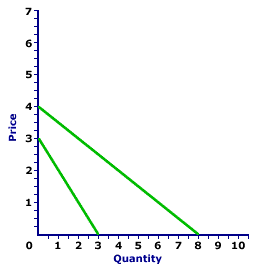Public goods (as well as near-public goods) are characterized by nonrival consumption, meaning that every member of society can receive benefits simultaneously. As such the overall value of public goods is obtained by summing the value that each individual receives for a given quantity. The nonrival nature of public goods consumption makes the derivation of the "market" demand different from that of private goods (as well as common-property goods). The difference is horizontal versus vertical.The market demand for private goods is derived through the horizontal summation of individual demand curves. The "market demand" for public goods is derived through the vertical summation of individual demand curves. For private goods, market demand answers the question: What is the total quantity that buyers would be willing to purchase at a given price? For public goods the total or "market" demand answers the question: What is the total value or benefit generated from consuming a given quantity?
The Market Demand for Private Goods
| Public Good Demand | 
|
To see the difference, first consider the market demand for private goods. The primary focus of the market demand for private goods is on the price that buyers pay. The total market demand is derived by adding up, or summing, the quantity demanded by every buyer at a given price.Take, for example, the market demand for stuffed animals (Wacky Willy Stuffed Amigos). This particular market contains only two buyers, Pollyanna Pumpernickel and Duncan Thurly. Suppose that Pollyanna is willing and able to purchase 2 stuffed animals at a $1 price and Duncan is willing and able to purchase 6 stuffed animals at this price.
In this case, the total market demand at the $1 price is 8 stuffed animals (2 + 6). The market demand curve is then derived by identifying the quantities that these two buyers would be willing and able to purchase at different prices.
The market demand is the horizontal summation of the individual demand curves of Pollyanna and Duncan. The quantities are horizontally summed for a given price. Click the [Private Demand] button to illustrate this derivation. The resulting red demand curve is the market demand for Wacky Willy Stuffed Amigos.
The Market Demand for Public Goods
Nonrival consumption makes the derivation of the demand for public goods a different story. Everyone can enjoy the benefits of a public good simultaneously. The consumption by one person does not prevent the consumption by another. As such, the value society receives from a public good is the sum of the value received by all who enjoy the benefits.This means that the demand for public goods is based on the vertical summation of individual demand curves.
Let's return to our two buyers, Pollyanna and Duncan, however, in this case they are consuming a public good, such as national defense. The focus of attention is now on the price each buyer would be willing to pay for a given quantity of the good (say 2 fighter jets). Suppose that Pollyanna is willing and able to pay $1 for a given level of defense and Duncan is willing and able to pay $3 for this level.
The total "market demand" is the sum of the prices that each is willing to pay, which is $4 ($1 + $3). The "market demand" curve is then derived by summing the prices that these two buyers would be willing and able to pay for different quantities. The "market demand" curve is the vertical summation of the individual demand curves of Pollyanna and Duncan. The prices are vertically summed for a given quantity. Click the [Public Demand] button to illustrate this derivation. This new red demand curve labeled D is now the "market demand" for the public good.
Why So?
The logic behind this private/public, horizontal/vertical difference is subtle, but key to an understanding of public goods.Efficiency dictates that the extra benefit generated by a good is equal to the extra opportunity cost of production. That is, the marginal benefit generated from the production of one more unit of the good is equal to the marginal cost of production. Because private goods are rival in consumption, the production of one more unit of the good can be consumed ONLY by ONE person. Efficiency is then achieve when the extra benefit received by that ONE person is equal to the extra cost of production.
The story is a different for public goods that are nonrival in consumption. Because public goods are consumed by EVERYONE simultaneously, the extra benefit derived from consumption is the extra benefit by EVERYONE combined, which is obtained by summing the extra benefit that each receives, that is, by summing the price each is willing to pay.
PUBLIC GOODS: DEMAND, AmosWEB Encyclonomic WEB*pedia, http://www.AmosWEB.com, AmosWEB LLC, 2000-2025. [Accessed: July 18, 2025].


